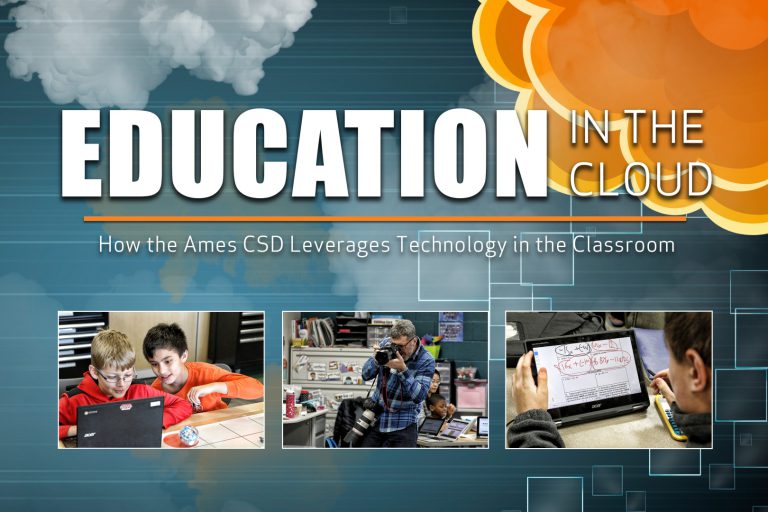

Education in the Cloud

This story was originally published in Volume 2 of Amazing Magazine that you can download here.
In December, Google visited the Ames Community School District to gather promotional materials that highlight some of the many ways in which our classrooms leverage Google Chromebooks. A group of three representatives visited classrooms in Ames Middle School and Edwards Elementary and witnessed first hand how their next generation Chromebooks were being utilized. The promotional materials that they gathered, namely photos and stories, were used in January at the British Education Training and Technology (BETT) show in London, England.
During the visit, their first stop was in Robyn Reisetter’s 7th grade math class where students were completing assignments with a stylus on the Explain Everything app. They then moved over to Willie Lodermeier’s 8th grade Technology Exploratory class where students showed off their TinkerCAD skills as they created models to be made in 3D printers.
After lunch, the Google team visited Amy Simonson’s kindergarten class where students were engaging with math principles on their Chromebooks thanks to software provided by an Iowa company, PearDeck. Students in Kimber Spaulding’s first grade class were coding using the Scratch app. Finally, a group of 5th graders, under the direction K-5 Technology Teacher Librarian Teresa Green, were having a blast with their “maker space” time. Some students were coding Sphero balls, others Hummingbird boards, and another group was working with LEGO EV3 Bricks.
1:1 Initiative
Last July, over 1,200 laptops arrived at the District Office for middle school students as the District continued its commitment to the 1:1 computer initiative that began in 2013. The goals of the initiative are wide ranging and have had a huge impact on students within the classroom and beyond. Students learn 21st Century skills, are able to create and collaborate using digital tools, and teachers are able to personalize learning centered around the individual needs of their students. One of the most significant aspects of the initiative is that it puts a computer in every student’s hands. Middle and high school students are issued a device at the beginning of the school year and keep them throughout the year.
Technology Director Karl Hehr said, “We do our best to maintain a 3 year cycle to make sure our devices are as up to date as possible for students and staff.” Last summer, the next generation Chromebooks were so new and cutting edge that the shipment that came to Ames were some of the first in the country. They have a multi-touch screen, stylus capabilities, and handwriting recognition, as well as assistive technology functions such as a language dictation tool. They also run Android (mobile) apps natively. Director Hehr summarized them by saying that they are “bigger, stronger, sturdier, and have more capabilities” than their predecessor. In many ways, the new Chromebooks are a laptop / tablet hybrid as the keyboard can fold behind the screen, allowing for better functionality and use of the world-facing camera.
Hehr has led the 1:1 initiative and sees it as a game changer in the Ames CSD. “We can put a device in every student’s hands, regardless of their background, and give them access to learning beyond the classroom. They are then able to explore passions on their own, and this has created areas where students can become lifelong learners.”
The 1:1 initiative is paid for primarily through PPEL funds, an important source of funding for the school district that was recently renewed for another 10 years in September 2017. The Physical Plant and Equipment Levy is a voter-approved tax on property valuation that generates about $4 million annually for the school district. “The Ames community has always been supportive of the school district and our initiatives. They have been very generous, and without their generosity, initiatives like the 1:1 laptop program would not be possible,” said Superintendent Dr. Tim Taylor. Staff computers are expected to be replaced in the summer of 2018, with high school devices next up in the summer of 2019.
Google in the Classroom
The Ames CSD functions from a digital standpoint thanks to Google. District employees and students have unlimited Gmail and online Drive storage thanks to the tech company, all at no cost to the District. They also leverage many other Google apps that include Docs, Photos, and Slides in the classroom.
“It was not my grand intent 7 years ago to solely use Google in this way, but it has worked out really well for us. There wasn’t really an alternative at the time, but it has been an easy transition to move everyone to Google,” said Director Hehr.
Integrating the use of technology in the classroom is important for student learning. Many have grown up with devices in their hands, but using technology appropriately is a vital 21st Century Skill that requires continual instruction. Students submit projects and assignments to teachers digitally through Google Classroom, which has been a “great way for students to be notified of assignments and for teachers to stay on top of assessments,” said Hehr.
These tools also allow students to expand their use of soft skills in the classroom, which is something that even Google recognizes as vitally important to the workplace. Students are not just using technology in isolation. They are collaborating on projects, communicating ideas with each other, and problem solving in real time, often in front of a computer.